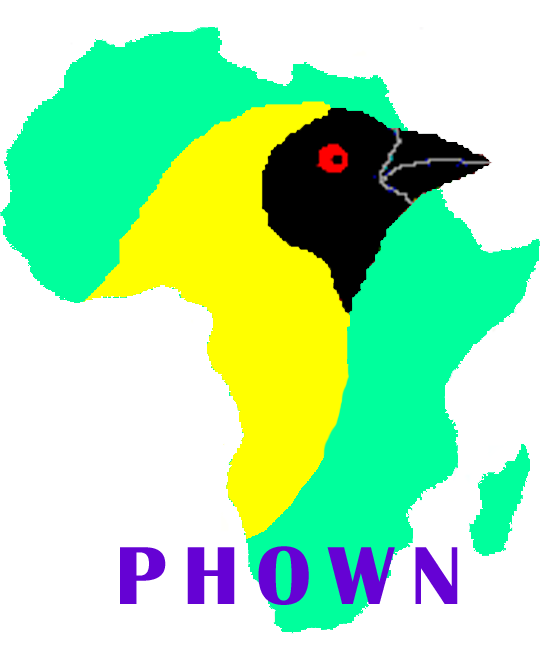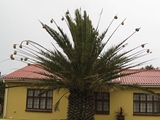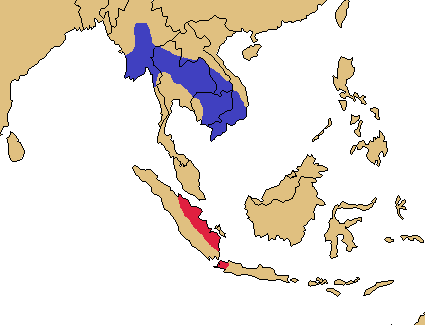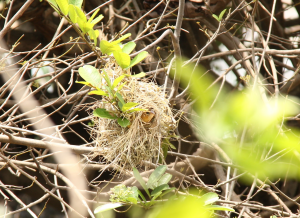Weaver species
Choose different species from drop-down list and press 'Go' button. See Full species list.Asian Golden Weaver Ploceus hypoxanthus
IUCN: Near threatened Discovery: 014Categories: Asian, IUCN, white eggs,
News items about species
Discovery
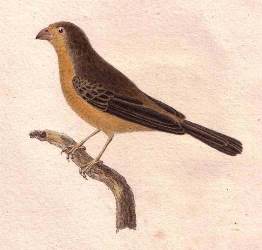
figure from Sparrman 1788 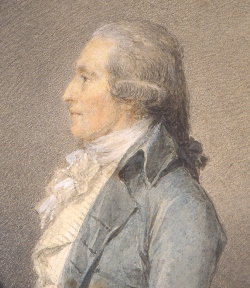
of the Asian Golden Weaver, figure from wikipedia 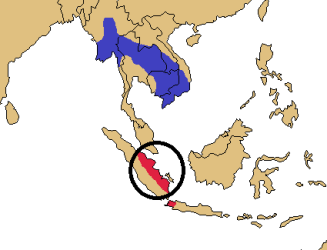
type locality circled IntroductionThe Asian Golden Weaver was formally named by Anders Erikson Sparrman, a Swedish naturalist. Although Sparrman sailed around the world with James Cook, starting from Cape Town, on Cook's second expedition to the Pacific (1772-1775), they did not visit islands as far north as Sumatra. After the voyage Sparrman returned to Cape Town in July 1775 and practiced medicine. In 1776 he returned to Sweden and published a Catalogue of the Museum Carlsonianum (1786-89), in which he described many of the specimens he had collected in South Africa and the South Pacific, some of which were new to science. He wrote a Latin description of the Asian Golden Weaver.Sparrman described and painted the Asian Golden Weaver, and listed the collector as Claes Fredrik Hornstedt, a Swedish naturalist. Hornstedt visited Batavia [=Jakarta] in Java from July 1783 to July 1784. He returned to Sweden with a large collection of natural history objects. In Sweden he replaced Sparrman as curator of the museum of the Royal Academy of Sciences (KVA), Stockholm, in 1787-88 (Rookmaaker 1989). Rookmaaker suggested that Hornstedt did not visit Sumatra, but received specimens from local collectors, even though he presents no evidence of this and Sumatra is relatively close to the adjacent island of Java. Latham (1801) noted that a bird was brought alive from Sumatra and kept by Count Carlson (in Museum Carlsonianum). Scientific citationLoxia hypoxantha Sparrman 1788 Mus. Carls., fasc., 3, p.71 Sumatra.Meaning of nameshypoxanthus (Greek) = hupo-, beneath; xanthos, golden or yellow [ie underparts golden].First English nameSumatran Grosbeak (Latham 1801).Alternate namesNone.CollectorClaes Fredrik Hornstedt.Date collected1783-84, when Hornstedt lived in Java.Locality collectedSumatra.Type specimensNo type specimens known to survive, but the painting of Sparrman serves as a type. |
The above is based on Weaver Wednesday 2, a weekly series about the discovery of each weaver species.
This species text first appeared as
Weaver Wednesday [131] - Discovery [14]: Asian Golden Weaver on 2014-12-17
1. Basic biology
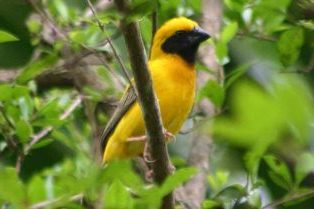
adult male, figure from wikipedia 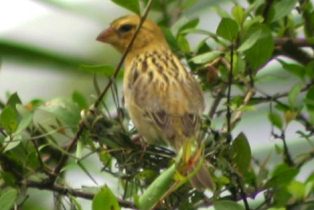
adult female, figure from wikipedia Identification. The Asian Golden Weaver Ploceus hypoxanthus is a Near Threatened species. The breeding male is generally bright yellow with a black mask (diagnostic in Asia). Females, non-breeding males and young birds are dull coloured and difficult to distinguish from the Baya Weaver, but has a thicker bill. Distribution.
There are two subspecies of the Asian Golden Weaver, with disjunct distributions (see map left, based on Handbook of the Birds of the World, Vol. 15:
The Asian Golden Weaver was formerly more widespread in Sumatra and Java, but is now localized and uncommon. Its population is showing a continued decline throughout its range as wetlands are converted to agriculture. There is also direct persecution and capture of these weavers for the bird trade, and colonies are often robbed and destroyed by people. The oldest bird is 11 years (see here). Habitat. The natural habitats of the Asian Golden Weaver are subtropical or tropical seasonally wet or flooded lowland grassland, swamps, and arable land. Food. The Asian Golden Weaver feeds mainly on seeds, and even during breeding insects were only 7% of their diet. Breeding.
The Asian Golden Weaver is apparently monogamous, and perhaps occasionally polygynous. It breeds in small colonies. The nest is initially built by the male, and completed with assistance of the female. The nest is a rounded structure with a side entrance, and woven from thin strips of grass or palm leaves. Nests are firmly attached to vegetation over water or very swampy ground, often less than 1m above the surface, usually in reeds or bulrushes. Sometimes nests are placed in trees or shrubs, and then higher than 2 m above the ground. There are several records of nests built close to hornet nests or near biting ants.
The clutch is 2 eggs, rarely 3. Incubation seems to be by the female only. Chicks are fed mainly by female (most often by regurgitation), and rarely by the male. There is no infomation on incubation and nestling periods. |
The above is based on Weaver Wednesday, a weekly series about weaver species.
This species text first appeared as
Weaver Wednesday [39]: Asian Golden Weaver on 2013-03-13
2. Breeding facts
| Pair bond Apparently monogmous, perhaps occasionally polygynous Breeding season Jul in Myanmar, Jul-Sept in Thailand, Aug in Laos and Jan-Jun in Java Nest site strongly attached to vegetation over water or very swampy ground, often less than 1 m above surface, usually in reeds or bulrushes (Typha), less commonly in tree or shrub and then higher than 2 m above ground Nest building built initially by male, completed with assistance of female Colony size small colonies Clutch size 2 eggs, rarely 3 Egg colour greyish-white, sometimes with a few spots Egg size average size of eleven eggs 18 x 13.5 mm (Java) Incubation incubation apparently by female only Chicks and nestling period chicks fed primarily by female (most often by regurgitation), only occasionally by male |
Breeding information based on Handbook of the Birds of the World, Vol. 15.
3. Photos of Weaver Nests
 Vm 5292 |  Vm 1255 |  Vm 1254 |  Vm 1253 |
Thumb-nails of most recent PHOWN records - click on one to see its full record
See all PHOWN records for this species here.
PHOWN (Photos of Weaver Nests) provides valuable info on breeding distribution and colony sizes of weavers.
You can contribute by registering and submitting photos at Virtual Museum webpage.
4. Breeding distribution
Google map showing distribution (For species with small ranges you need to zoom in at the correct area to see the range):
yellow blob - range of weaver species; read more about this here.
![]() - PHOWN records with photos
- PHOWN records with photos
![]() - PHOWN records with no photos (Nest Record Cards, other records)
- PHOWN records with no photos (Nest Record Cards, other records)
![]() - Birdpix records
- Birdpix records
![]() - comments on out of range records, or interesting records
- comments on out of range records, or interesting records
![]() - type locality
- type locality
CLICK on the marker on the map to see individual record details.
5. Range changes
Not South African speciesThe above is based on Weaver Wednesday 3, a weekly series about range changes in South African weaver species.
This species text first appeared as
n/a







